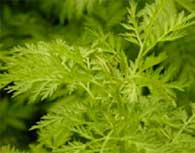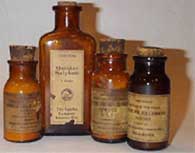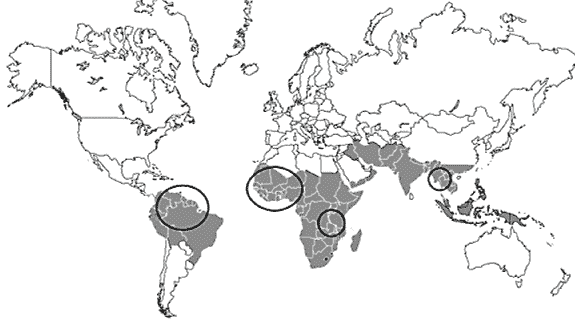Antimalarial Drugs
How can malaria be treated? In the past quinine was the only medication that could stop the disease. But now many different drugs treat malaria. But how does a physician know which drug to give?
|
Photo courtesy of Marvin Samson Center for the History of Pharmacy, University of the Sciences, Michael J. Brody. Quinine has been used as a remedy for malaria for many years. |
 Photo courtesy of National Research Council. The plant Artemisia annua was long used in China as an antimalarial. The active ingredient in this plant, artemisinin, is the basis of the newest class of antimalarial drugs. |
Quinine was the only effective treatment for malaria from the mid-17th century until the middle of the 20th century. In 1946, British and American scientists tested an antimalarial drug discovered in 1934 by a German researcher. The drug chloroquine became the first synthesized compound used to treat malaria. Since then, other drugs have joined quinine and chloroquine, including sulfadoxine-pyrimethamine (Fansidar), mefloquine (Lariam), atovaquone-proguanil (Malarone), and doxycycline. Fansidar is most effective for people with some malaria resistance. The drug primaquine treats the dormant liver parasites, to prevent relapses. However, it causes serious complications and is rarely used.
The newest drug to treat malaria comes from China. The ancient Chinese found that the Qinghao plant—Latin name Artemisia annua, also known as sweet wormwood—reduced fevers. In 1971, Chinese scientists isolated the active ingredient, artemisinin. Derivatives of this ingredient are a very effective drug against malaria. Although used around the world, artemisinin-derivative drugs are not licensed in the United States.
The infecting parasite and the region where the person picked up the infection determine which antimalarial drug to use. The reason: drug resistance, particularly against Plasmodium falciparum and P. vivax. In the late 1950s, reports of chloroquine-resistant P. falciparum surfaced in South America and South Asia. Subsequently, this resistance in P. falciparum spread around the world. Other drugs must now be used to treat malaria caused by this Plasmodium species. In some regions P. falciparum developed resistance to almost all of the other drugs used to treat malaria. So far, the artemisinin derivatives remain effective. Occasional reports of artemisinin-resistant P. falciparum have surfaced in recent years. Some regions report P. vivax resistance to some drugs, including chloroquine and Fansidar.
|
Photo courtesy of CDC. On this map of the world, the areas in gray show where the malaria parasite has developed resistance to chloroquine. The circles show where the parasite is resistant to other drugs as well. |
There are two ways to combat resistance. Each antimalarial drug affects the parasites differently. So to prevent resistance from developing any further, drugs with different actions on the parasites can be given in combination. This confuses the parasite, preventing it from gaining enough time in the body to develop resistance. For example, artemisinin combination therapy, known as ACT, makes a very effective treatment against P. falciparum. The second way is to take the drug according to instructions, for a full dosage. This wipes out the parasite completely.
Another factor considered when selecting antimalarial drugs for treatment is the overall condition of the patient: other illnesses, drug allergies, and, for women, the possibility of pregnancy.
Are there other reasons why malaria drugs don’t always work? Read on…
Counterfeit Drugs
In countries where malaria is common and widespread, the people most likely to get the illness are also those least able to afford the medicine needed to treat it. In these regions a significant trade in fake malaria medications has sprung up. These medications are not effective against the parasite, but they are cheaper and thus more affordable to people on very limited incomes. What makes these medications counterfeit and how can they be identified?
In countries where malaria is common, the poorest people are also the people most likely to get bitten by a mosquito carrying the malaria parasite. This is because poorer people have minimal access to the techniques that prevent malaria, such as bed nets, window screens, and insecticide sprays. These same people also do not have the money for antimalarial medications. Criminals are offering inexpensive antimalarials in poorer areas. The problem is that these medicines are counterfeit: they do not work, and can, in fact, promote the development of resistance by the parasite to these new drugs. This problem is particularly prevalent in Southeast Asia and Africa.
The drugs commonly counterfeited are the artemisinin-based antimalarials. These medications are new and expensive. However, they are very effective against the parasite, particularly in regions where malaria has become resistant to older antimalarial drugs. Most of the counterfeit drugs come from China, also the source of the genuine artemisinin-based drugs.
The obvious problem with the fake drugs is that the patient does not get better, and may die. Drugs can be counterfeit in a number of ways. They may be old and out of date, and thus no longer effective against the parasite. They may contain no actual antimalarial medication. And, most dangerous for everyone, they may contain less than the stated amount of active ingredient.
The ones that contain too little of the active ingredient pose the biggest problem. Widespread use of these fakes exposes the parasite to the artemisinin-based drugs, but not in doses large enough to kill the parasite. This level of exposure can help the parasite develop resistance to this antimalarial. The low doses kill the least resistant parasites and leave the stronger, more resistant ones alive to reproduce. Over time, the parasite population would contain more of the resistant parasites. Resistance to artemisinin drugs would be a disaster because there are no other new antimalarial drugs ready for use.
There are a number of ways to identify the fake drugs. Antimalarials sold on the street are most likely to be counterfeit. If the medicine is less expensive than expected it is likely to be fake as well. These pills should be sold in blister packages, not as pills from a bottle. Some counterfeiters are very sophisticated and use official-looking packaging. On close inspection, however, the packaging may be imperfect, with blurred printing or a missing hologram. Medicines that taste funny, have a funny smell, or are particularly brittle also may be fakes. The best way to avoid counterfeit medicines is to go to a reliable pharmacy.
So what prevents malaria from sickening everybody during an outbreak? There are there ways people can become immune to this disease.
This content has been re-published with permission from SEED. Copyright © 2025 Schlumberger Excellence in Education Development (SEED), Inc.



